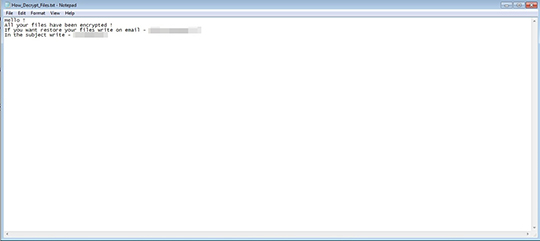RANSOM_BLIND.C
Trojan-Ransom.Win32.Gen.gfj (Kaspersky), Ransom.CryptXXX (Norton), Troj/Blind-A (SOPHOS_LITE)
Windows


Threat Type: Ransomware
Destructiveness: No
Encrypted: No
In the wild: Yes
OVERVIEW
Dropped by other malware, Downloaded from the Internet
This Ransomware arrives on a system as a file dropped by other malware or as a file downloaded unknowingly by users when visiting malicious sites.
It drops files as ransom note.
TECHNICAL DETAILS
651264 bytes
EXE
No
05 Feb 2018
Terminates processes, Displays message/message boxes, Encrypts files
Arrival Details
This Ransomware arrives on a system as a file dropped by other malware or as a file downloaded unknowingly by users when visiting malicious sites.
Process Termination
This Ransomware terminates processes or services that contain any of the following strings if found running in the affected system's memory:
- oracle.exe
- sqlserver.exe
Other Details
This Ransomware does the following:
- It encrypts all files in fixed and network drives.
Ransomware Routine
This Ransomware appends the following extension to the file name of the encrypted files:
- .[skeleton@{BLOCKED}e.lol].skeleton
It drops the following file(s) as ransom note:
- {Folders Containing Encrypted Files}How_Decrypt_Files.txt
NOTES:
This ransomware drops the following ransom note:
SOLUTION
9.850
13.842.03
13.843.00
Step 1
Before doing any scans, Windows XP, Windows Vista, and Windows 7 users must disable System Restore to allow full scanning of their computers.
Step 2
Note that not all files, folders, and registry keys and entries are installed on your computer during this malware's/spyware's/grayware's execution. This may be due to incomplete installation or other operating system conditions. If you do not find the same files/folders/registry information, please proceed to the next step.
Step 3
Search and delete this file
- {Folders Containing Encrypted Files}How_Decrypt_Files.hta
Step 4
Scan your computer with your Trend Micro product to delete files detected as RANSOM_BLIND.C. If the detected files have already been cleaned, deleted, or quarantined by your Trend Micro product, no further step is required. You may opt to simply delete the quarantined files. Please check the following Trend Micro Support pages for more information:
Step 5
Restore encrypted files from backup.
Did this description help? Tell us how we did.

